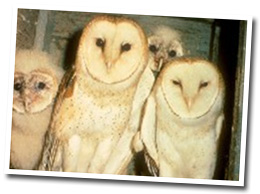 The state endangered Barn Owl is a savanna species that nests and roosts in dark, secluded places. Historically, it nested in tree cavities, specifically in silver maple, American sycamore, and white oak. Today, barn owls are often found roosting and nesting in old barns or abandoned buildings. Barn owls hunt in grassland habitats along field edges, fence-rows, and wetland edges where their favored prey is most available.
The state endangered Barn Owl is a savanna species that nests and roosts in dark, secluded places. Historically, it nested in tree cavities, specifically in silver maple, American sycamore, and white oak. Today, barn owls are often found roosting and nesting in old barns or abandoned buildings. Barn owls hunt in grassland habitats along field edges, fence-rows, and wetland edges where their favored prey is most available.
Except in the northernmost areas, barn owls have 2 broods each year, usually in spring and late summer. 4-7 eggs hatch after several weeks. Both parents brood and feed the young. Young mature in 10-12 weeks.
Common barn owls are threatened by the loss of prey habitat. The barn owl's primary prey are voles and to a lesser extent mice. Crop rotational changes from cover crops such as oats and hay to row crops like corn remove food and shelter for mice and voles. Development of land, removal of hedgerows and draining of wetlands also has destroyed much of the barn owl habitat. Loss of nesting habitat is also an increasing threat. It is common to remove large dead trees that provide good nest cavity sites. Many landowners have replaced wooden barns and corncribs, where barn owls once nested, with modern metal farm buildings. Large scale removal of abandoned farm buildings and adjoining wood lots has also diminished nest sites. Great horned owl predation on barn owls is a major threat to this smaller owl's existence, since both species share similar habitats. Since a barn owls diet is almost exclusively rodents, rodenticide use on farmsteads can cause poisoning of barn owls.
To attract barn owls to your property establish grassland habitat to attract prey. Providing about 200 acres of quality grassland adjacent to a potential barn owl nest site can yield good results. Maintain old farmsteads with wooden barns, woodlots, and adjoining grasslands, especially if barn owls are known to frequent the area. Nest boxes can be used in place of cavity trees or abandoned buildings. Placing predator-proof barn owl nest boxes in abandoned buildings can be especially effective. Minimize rodenticide use in areas known to have barn owl populations. Barn owls will act as natural control for many common pests.
Barn Owl Brochure with Box Plans
Nesting Structures/Bird Houses
For thousands of years, waterfowl, songbirds, raptors and all other wildlife species survived and reproduced in the natural habitats of North America without human assistance. However, with the arrival of the first European settlers, those natural habitats began to change. Millions of acres of wetlands, prairie, and forest were altered for human use, leaving wildlife to survive on a small fraction of the habitat that once supported their ancestors in sky-darkening numbers.
To help wildlife populations maintain themselves under these altered conditions, wildlife biologists have developed various techniques to improve habitat and increase nest success. The use of artificial nest structures for the production of some waterfowl, songbird, and raptor species is one of these techniques.
It is important to realize that nest structures will not solve all the problems facing wildlife today. Nest structures only improve nest success for the few species that use them. The real problem facing our wildlife populations is the continued loss of their natural wetland, grassland, and woodland habitats. This trend will only be reversed by sound land stewardship practices that address wildlife habitat requirements as well as human needs.
Bird Houses/Nesting: